HONDA PRELUDE 1992 Owner's Manual
Manufacturer: HONDA, Model Year: 1992, Model line: PRELUDE, Model: HONDA PRELUDE 1992Pages: 225, PDF Size: 2.1 MB
Page 21 of 225
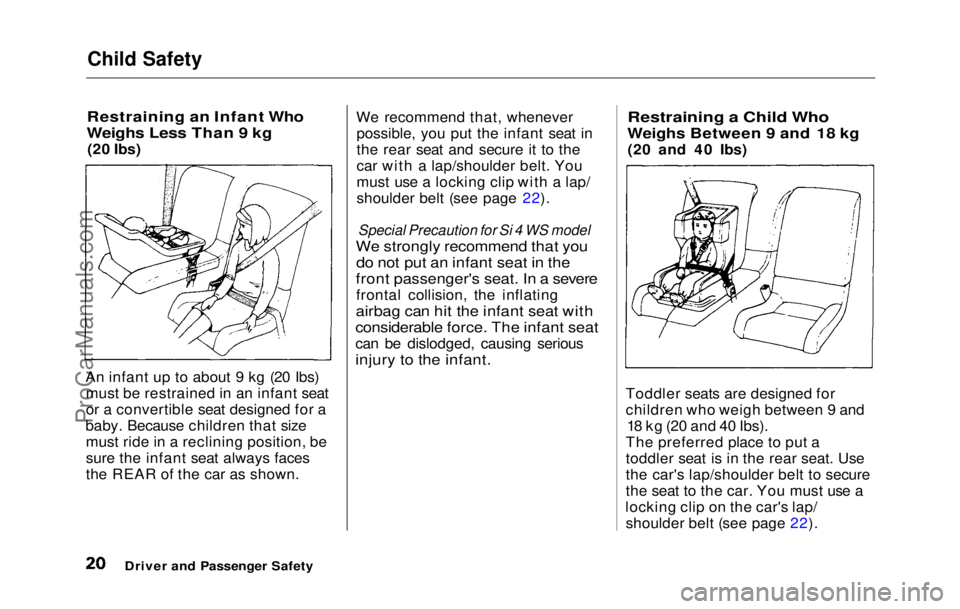
Child Safety
Restraining an Infant Who
Weighs Less Than 9 kg
(20 Ibs)
An infant up to about 9 kg (20 Ibs) must be restrained in an infant seat
or a convertible seat designed for a
baby. Because children that size must ride in a reclining position, be
sure the infant seat always faces
the REAR of the car as shown. We recommend that, whenever
possible, you put the infant seat in
the rear seat and secure it to the
car with a lap/shoulder belt. You
must use a locking clip with a lap/
shoulder belt (see page 22).
Special Precaution for Si 4 WS model
We strongly recommend that you do not put an infant seat in the
front passenger's seat. In a severe
frontal collision, the inflating
airbag can hit the infant seat with
considerable force. The infant seat
can be dislodged, causing serious
injury to the infant.
Restraining a Child Who
Weighs Betwee n
9 and 18 kg
(20 and 40 Ibs)
Toddler seats are designed for
children who weigh between 9 and 18 kg (20 and 40 Ibs).
The preferred place to put a
toddler seat is in the rear seat. Use
the car's lap/shoulder belt to secure
the seat to the car. You must use a
locking clip on the car's lap/ shoulder belt (see page 22).
Driver and Passenger SafetyProCarManuals.comMain Menu Table of Contents s t
Page 22 of 225
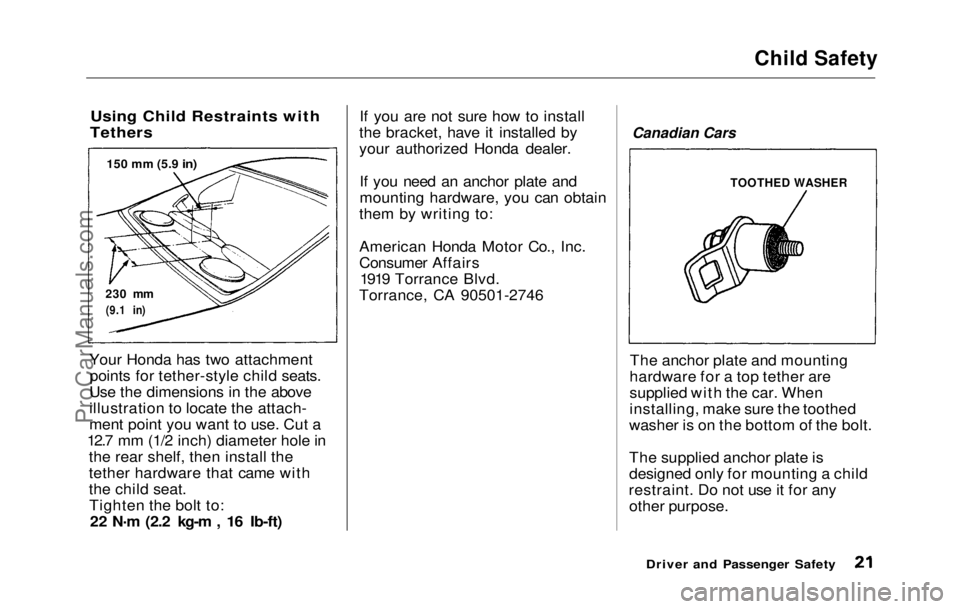
Child Safety
Using Child Restraints with
Tethers
Your Honda has two attachment points for tether-style child seats.
Use the dimensions in the above
illustration to locate the attach-
ment point you want to use. Cut a
12.7 mm (1/2 inch) diameter hole in the rear shelf, then install the
tether hardware that came with
the child seat.Tighten the bolt to: 22 N .
m (2.2 kg-m , 16 Ib-ft) If you are not sure how to install
the bracket, have it installed by
your authorized Honda dealer.
If you need an anchor plate and
mounting hardware, you can obtain
them by writing to:
American Honda Motor Co., Inc.
Consumer Affairs 1919 Torrance Blvd.
Torrance, CA 90501-2746
Canadian Cars
The anchor plate and mounting
hardware for a top tether are
supplied with the car. When
installing, make sure the toothed
washer is on the bottom of the bolt.
The supplied anchor plate is
designed only for mounting a child
restraint. Do not use it for any other purpose.
Driver and Passenger Safety
TOOTHED WASHER
150 mm (5.9
in)
230 mm
(9.1 in)ProCarManuals.comMain Menu Table of Contents s t
Page 23 of 225
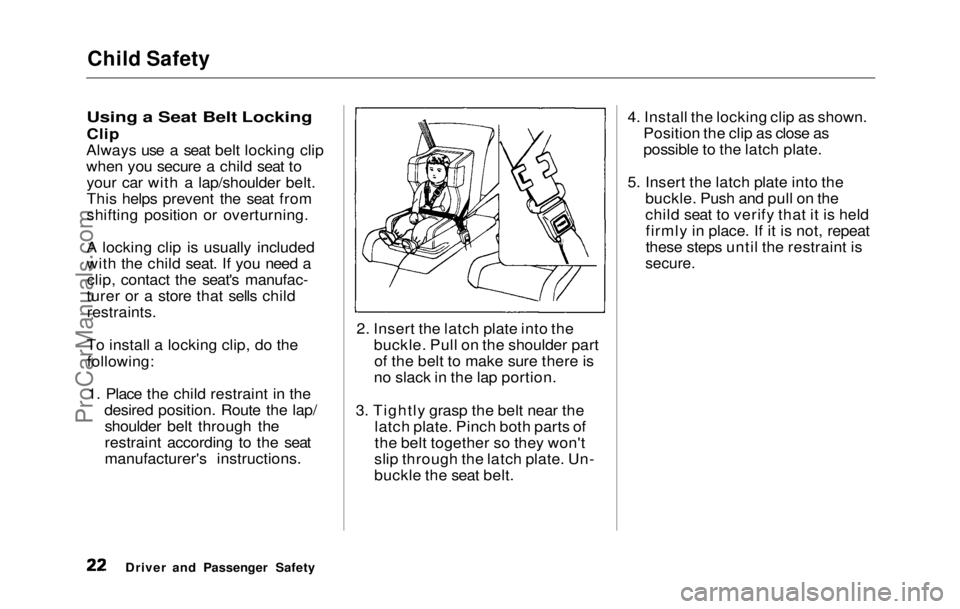
Child Safety
Using a Seat Belt Locking
Clip
Always us
e a seat belt locking clip
when you secure a child seat to your car with a lap/shoulder belt.
This helps prevent the seat from
shifting position or overturning.
A locking clip is usually included
with the child seat. If you need aclip, contact the seat's manufac-
turer or a store that sells child restraints.
To install a locking clip, do the following:
1. Place the child restraint in the
desired position. Route the lap/shoulder belt through the
restraint according to the seat
manufacturer's instructions.
2. Inser t
the latch plate into the
buckle. Pull on the shoulder part
of the belt to make sure there is
no slack in the lap portion.
3. Tightl y
grasp the belt near the
latch plate. Pinch both parts of
the belt together so they won't
slip through the latch plate. Un-
buckle the seat belt.
4. Instal l
the locking clip as shown.
Position the clip as close as
possible to the latch plate.
5. Insert the latch plate into the
buckle. Push and pull on the
child seat to verify that it is held firmly in place. If it is not, repeat
these steps until the restraint is
secure.
Driver an d
Passenger SafetyProCarManuals.comMain Menu Table of Contents s t
Page 24 of 225
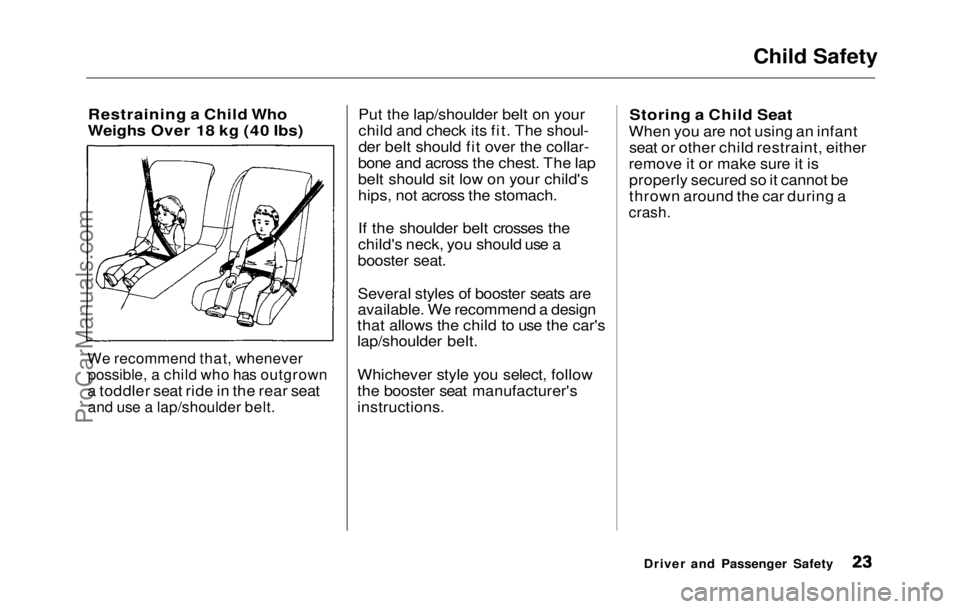
Child Safety
Restraining a Chil
d Who
Weighs Over 18 kg (40 Ibs)
We recommend that, whenever
possible, a child who has outgrown
a toddler seat ride in the rear seat
and use a lap/shoulder belt.
Put the lap/shoulder belt on your
child and check its fit. The shoul-
der belt should fit over the collar-
bone and across the chest. The lap
belt should sit low on your child's
hips, not across the stomach.
If the shoulder belt crosses the
child's neck, you should use a
booster seat.
Several styles of booster seats are
available. We recommend a design
that allows the child to use the car's
lap/shoulder belt.
Whichever style you select, follow
the booster seat manufacturer's
instructions.
Storing a Child Seat
When you are not using an infant seat or other child restraint, either
remove it or make sure it is properly secured so it cannot be
thrown around the car during a
crash.
Driver and Passenger SafetyProCarManuals.comMain Menu Table of Contents s t
Page 25 of 225
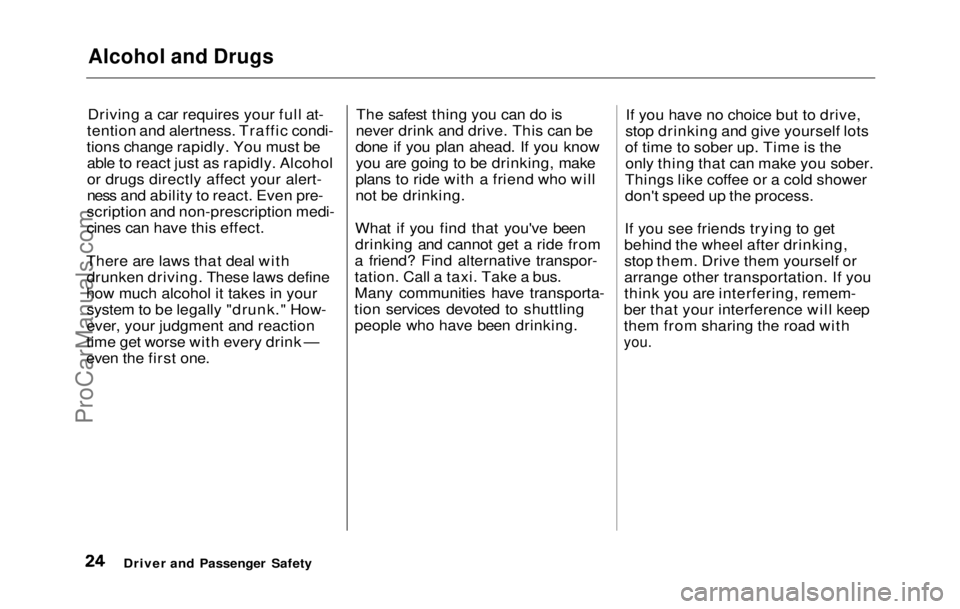
Alcohol and Drugs
Driving a car requires your full at-
tention and alertness. Traffic condi-
tions change rapidly. You must be able to react just as rapidly. Alcohol
or drugs directly affect your alert-
ness and ability to react. Even pre-
scription and non-prescription medi-
cines can have this effect.
There are laws that deal with drunken driving. These laws define
how much alcohol it takes in your system to be legally "drunk." How-
ever, your judgment and reaction
time get worse with every drink —
even the first one. The safest thing you can do is
never drink and drive. This can be
done if you plan ahead. If you know you are going to be drinking, make
plans to ride with a friend who will
not be drinking.
What if you find that you've been
drinking and cannot get a ride from
a friend? Find alternative transpor-
tation. Call a taxi. Take a bus.
Many communities have transporta-
tion services devoted to shuttling people who have been drinking.If yo
u
have no choice but to drive,
stop drinking and give yourself lots
of time to sober up. Time is the only thing that can make you sober.
Things like coffee or a cold shower
don't speed up the process.
If you see friends trying to get
behind the wheel after drinking,
stop them. Drive them yourself or
arrange other transportation. If you
think you are interfering, remem-
ber that your interference will keep
them from sharing the road with
you.
Driver and Passenger SafetyProCarManuals.comMain Menu Table of Contents s t
Page 26 of 225

Carbon Monoxide Hazard
Your car's exhaust contains carbon monoxide gas. You should have no
problem with carbon monoxide
entering the car in normal driving
if you maintain your car properly.
Have the exhaust system inspected
for leaks whenever: The car is raised for an oil
change.
You notice a change in the sound
of the exhaust.
The car was in an accident that
may have damaged the under-
side.
High levels of carbon monoxide can
collect rapidly in enclosed areas,
such as a garage. Do not run the
engine with the garage door closed.
Even with the door open, run the
engine only long enough to move
the car out of the garage.
With the trunk lid open, air flow
can pull exhaust gas into the trunk.
This can get into your car's interior
and create a hazardous condition. If
you must drive with the trunk lid
open, open all the windows and set
the heating and cooling system as
shown in the next column. If you must sit in your parked car,
even in an unconfined area, with
the engine running, adjust the
heating and cooling system as
follows:
1. Select the Fresh Air mode. 2. Select the mode.
3. Turn the fan on high speed.
4. Set the temperature control to a comfortable setting.
Driver and Passenger Safety
Carbon monoxide gas is toxic.
Breathing it can cause uncon-
sciousness and can even kill
you.
Avoid any enclosed areas or
activities that expose you to
carbon monoxide.ProCarManuals.comMain Menu Table of Contents s t
Page 27 of 225
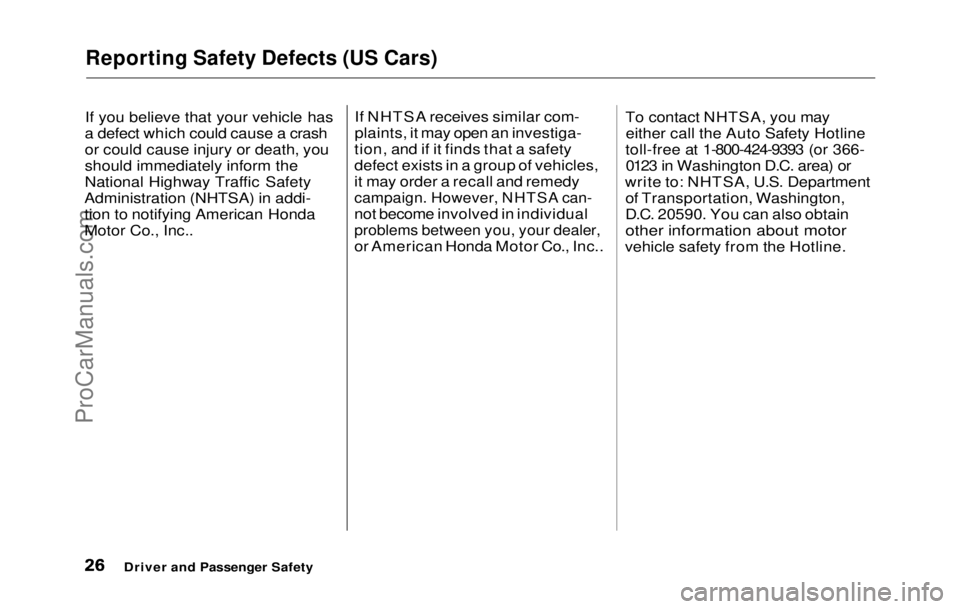
Reporting Safety Defects (US Cars)
If you believe that your vehicle has
a defect which could cause a crash
or could cause injury or death, you
should immediately inform the
National Highway Traffic Safety
Administration (NHTSA) in addi-
tion to notifying American Honda
Motor Co., Inc.. If NHTSA receives similar com-
plaints, it may open an investiga-
tion, and if it finds that a safety
defect exists in a group of vehicles,
it may order a recall and remedy
campaign. However, NHTSA can-
not become involved in individual
problems between you, your dealer,
or American Honda Motor Co., Inc.. To contact NHTSA, you may
either call the Auto Safety Hotline
toll-free at 1-800-424-9393 (or 366- 0123 in Washington D.C. area) or
write to: NHTSA, U.S. Department of Transportation, Washington,
D.C. 20590. You can also obtai nother information about motor
vehicle safety
from the Hotline.
Driver and Passenger SafetyProCarManuals.comMain Menu Table of Contents s t
Page 28 of 225

Safety Labels
These labels are in the locations shown. They warn you of potential
hazards that could cause seriousinjury. Read these labels carefully
and don't remove them.
If a label comes off or becomes
hard to read, contact your Honda
dealer for a replacement.
Driver and Passenger Safety
RADIATOR CAP
BATTERYProCarManuals.comMain Menu Table of Contents s t
Page 29 of 225

Instruments and Controls
This section gives information
about the controls and displays that
contribute to the daily operation of
your Honda. All the essential
controls are within easy reach.
Control Locations......................... 30
Indicator Lights.............................. 31
Gauges............................................. 37
Speedometer
.............................
37
Tachometer................................. 37
Odometer
.................................... 37
Trip Meter................................... 37
Fuel Gauge..................................
38
Temperature Gauge
..................
38
Controls Near the
Steering
Wheel
....................................... 39
Headlights................................... 40
Daytime Running Lights.......... 40
Instrument Panel Brightness... 41
Turn Signals................................ 41
Windshield Wipers.....................
42
Windshield Washers.................
42
Steering Wheel Adjustment ....
. 43
Steering Wheel Controls............... 44
Cruise Control............................ 44
Horn ............................................ 47
Keys and Locks.............................. 47
Keys.............................................. 47
Ignition Switch........................... 47
Door Locks.................................. 48
Power Door Locks ..................... 48
Trunk.......................................... 50
Seat Adjustments........................... 51
Rear Seat Access........................ 52
Additional Driver' s
Seat
Adjustments...........................
53
Seat Heaters.................................... 54
Folding Rea r
Seat.......................... 55
Hazard Warning............................ 56
Rear Window Defogger ................ 56
Power Windows.............................. 57
Sunroof ...........................................
58
Mirrors ........................................... 59
Parking Brake................................ .
61
Glove Box........................................
.
62
Digital Clock..................................
.
63
Center Console Compartment .... 64
Vanity
Mirror
..............................
64
Cigarette Lighter
..........................
.
65
Ashtray........................................... 65
Interior Lights...............................
.
66
Instruments an
d
ControlsProCarManuals.comMain Menu s t
Page 30 of 225

Control Locations
MIRROR
CONTROLS(P.60)
FUEL FILLER
DOOR RELEASE
(P.100) DOOR LOCK
SWITCH (P.49) POWER WINDOW
SWITCH
(P.57) DIGITAL CLOCK
(P.63)
TRUNK RELEASE HANDLE
(P.50)
HOOD RELEASE
HANDLE
(P.101)
HEATING/
COOLING
CONTROL
(P.68)
AUDIO SYSTEM (P.75, 84)
Instruments and ControlsProCarManuals.comMain Menu Table of Contents s t